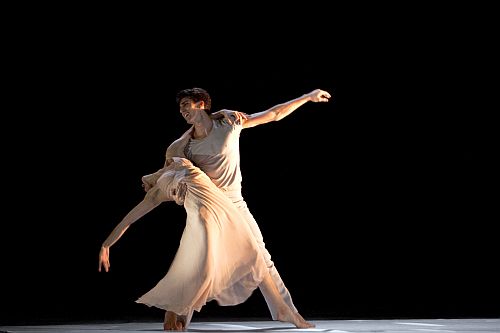 United Kingdom Debussy, Berlioz, Stravinsky , Sacre: Sasha Waltz & Guests, Sadler’s Wells, London 11.11.2015 (J.O’D)
United Kingdom Debussy, Berlioz, Stravinsky , Sacre: Sasha Waltz & Guests, Sadler’s Wells, London 11.11.2015 (J.O’D)

Scène d’Amour
Emanuela Montanari, Antonino Sutera
L’Après-midi d’un faune
Dancers:
Jirí Bartovanec, Davide Camplani, Juan Kruz Diaz de Garaio Esnaola, Luc Dunberry, Maya Gomez, Hwanhee Hwang, Virgis Puodziunas, Sasa Queliz, Mata Sakka, Yael Schnell, Joel Suárez Gómez
Production
Choreographer: Sasha Waltz
Composer: Claude Debussy – L’Après-midi d’un faune
Stage & Costume: GIOM/Guillaume Bruère
Light: Martin Hauk
Scène d’Amour
Dancers:
Lorena Justribó Manion, Ygal Tsur
Production
Choreographer: Sasha Waltz
Composer: Hector Berlioz – Roméo et Juliette
Costume: Bernd Skodzig
Sacre
Dancers:
Liza Alpizar Aguilar, Ayaka Azechi, Blenard Azizaj, Jirí Bartovanec, Davide Camplani, Maria Mart Colusi, Juan Kruz Diaz de Garaio Esnaola, Luc Dunberry, Delphine Gaborit, Maya Gomez, Peggy Grelat-Dupont, Hwanhee Hwang, Lorena Justribó Manion, Margaux Marielle-Tréhouart, Sergui Matis, Michal Mualem, Davide Di Pretoro, Virgis Puodziunas, Sasa Queliz, Zaratiana Randrianantenaina, Mata Sakka, Indalecio Seura, Corey Scott-Gilbert, Joel Suárez Gómez, Antonios Vais and children (Jude Letullier Grelat, Oscar Linahan)
Production
Choreographer: Sasha Waltz
Composer: Igor Stravinsky – The Rite of Spring
Costume: Bernd Skodig
Stage: Pia Maier Schriever, Sasha Waltz
Light: Thilo Reuther
A woman leans back in sensuous enjoyment as the bare-chested man kneeling over her draws circles in lipstick on her calf and thigh. A man curls up happily as if to dream of his departed female lover. A second woman falls down, naked and dead, as the tip of a stalactite-like object that has been descending from the flies for some time makes contact with the floor. For whatever reason, each work in this triple bill by the German choreographer, Sasha Waltz, ends with a dancer lying in the centre of the stage.
Sacre, which gives the triple bill its name, was created in 2013 as a tribute to Stravinsky’s The Rite of Spring, and to the 1913 ballet of that name. In its UK premiere, it is preceded by what the programme notes call ‘choreographies’ of Debussy’s Prélude à l’après-midi d’un faune, and Scène d’Amour from Berlioz’s Roméo et Juliette. The applause for the first was tepid. For the second, it began to be warm. For Sacre itself, and for the brightly-lit dance of death by the naked dancer, the Sadler’s Wells audience went wild.
They keep you at a distance, the men and women in vibrant leotard/swimsuits on the stage of L’Après-midi d’un faune. Alone, in twos or threes and in groups, they bend very much from the waist while looking at each other in wary fascination. Patches of colour on the oddly hung, oddly placed backdrop echo those on Nijinsky’s faun costume for the original ballet in 1912. This music will always be about ‘adolescent sexual awakening’ of some sort or another. And perhaps he is not unlike Nijinsky, substituting the nymph’s scarf for the nymph herself, the man with the lipstick at the end.
Scène d’Amour is danced only by the two lovers. That, and the Berlioz score, make it a more passionate affair. Even here, though, there is a contrasting coldness in the double rhomboid design of the white floor, the man’s grey clothes, the woman’s flesh-coloured dress (a dress that, in a different shade, Grace Kelly might have worn). What she gives with one hand, in terms of visual and aural pleasure, Sasha Waltz takes away with the other. The choreography involves a restless twisting of the shoulders, a constant coming together and moving apart. The couple are first seen lying in awkward positions at opposite sides of the stage. In the closing moments the woman leaves altogether.
Described on the poster as ‘A contemporary take on the Stravinsky classic’, Sacre seems also to reach back to German expressionist dance of the early twentieth century. Two men might kiss, feverishly, during an orgy. Elsewhere they and the other dancers arrange their bodies in Mary Wigmanesque poses of ‘ornamental despair’ (to borrow, once again, the phrase Siegfried Kracauer, in From Caligari to Hitler, applies to a scene from Fritz Lang’s Metropolis).
Costume designer Bernd Skodzig clothes this despair in sleeveless, side-slit column dresses for the women of almost indefinably delicate hue. Cinnamon? Lavender? Dove grey? In these they shuffle and stamp their feet, jump into the air, run with their arms held stiffly forwards. When a woman is helped into a dress of deep purple, you know that there is going to be a ‘Chosen One’, and that it’s her.
During a collective scurry, two children make their appearance. For the rest of the dance you watch what happens through their eyes. More and more of the men begin to come on in priest-like robes. Eventually, the dancers gather in a corner. The Chosen One alone stands facing them. When she removes her dress, they kneel. Nakedness on the stage is often covered by its brevity, or by shadow. Here there are no shadows. The audience watches in stillness as the woman leaps and turns, flinging out her limbs. What started as a rite that is represented has almost become a rite that is real.
John O’Dwyer